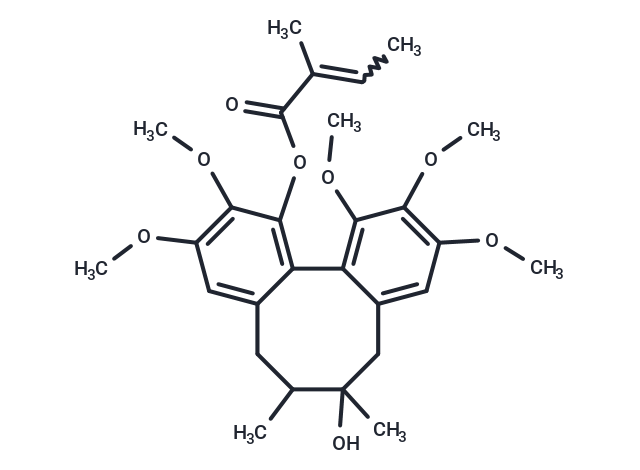Shopping Cart
- Remove All
 Your shopping cart is currently empty
Your shopping cart is currently empty

Tigloylgomisin H significantly induces quinone reductase (QR) activity in Hepa1c1c7 mouse hepatocarcinoma cells. Tigloylgomisin H functions as a novel monofunctional inducer that specifically upregulates phase II enzymes through the Nrf2-ARE pathway and can be used in liver cancer prevention studies.

| Pack Size | Price | Availability | Quantity |
|---|---|---|---|
| 1 mg | $48 | In Stock | |
| 5 mg | $118 | In Stock | |
| 10 mg | $198 | In Stock | |
| 25 mg | $339 | In Stock | |
| 50 mg | $474 | In Stock | |
| 100 mg | $654 | In Stock | |
| 1 mL x 10 mM (in DMSO) | $160 | In Stock |
| Description | Tigloylgomisin H represents a potential liver cancer prevention agent, it can significantly induce quinone reductase (QR) activity in Hepa1c1c7 mouse hepatocarcinoma cells, it functions as a novel monofunctional inducer that specifically upregulates phase |
| In vitro | In the current study, nine lignans were isolated from S. chinensis and tested for their ability to induce quinone reductase (QR) activity in Hepa1c1c7 mouse hepatocarcinoma cells. Tigloylgomisin H (TGH) and angeloylgomisin H (AGH) significantly induced QR activity and exhibited a relatively high chemoprevention index (CI) (10.80 and 4.59, respectively) as compared to control. TGH also induced QR activity in BPrc1 mouse hepatocarcinoma cells as well, which are defective in aryl hydrocarbon nuclear translocator (Arnt). In HepG2 human hepatocarcinoma cells, TGH significantly activated gene expression mediated by the antioxidant response element (ARE), a key regulatory region in the promoters of detoxification enzymes, through the nuclear accumulation of Nrf2. |
| Molecular Weight | 500.58 |
| Formula | C28H36O8 |
| Cas No. | 66069-55-4 |
| Smiles | O(C(C(=CC)C)=O)C1=C2C=3C(=CC(OC)=C(OC)C3OC)CC(C)(O)C(C)CC2=CC(OC)=C1OC |
| Relative Density. | 1.144 g/cm3 (Predicted) |
| Storage | Powder: -20°C for 3 years | In solvent: -80°C for 1 year | Shipping with blue ice. | ||||||||||||||||||||||||||||||
| Solubility Information | DMSO: 50 mg/mL (99.88 mM) | ||||||||||||||||||||||||||||||
Solution Preparation Table | |||||||||||||||||||||||||||||||
DMSO
| |||||||||||||||||||||||||||||||

Copyright © 2015-2024 TargetMol Chemicals Inc. All Rights Reserved.